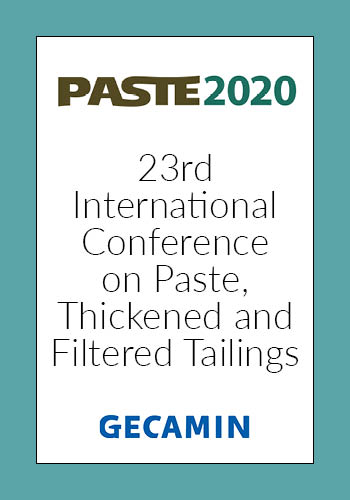Pressure Filter Feeding Methods - Case Study

|
Authors: Silva, M |
DOI https://doi.org/10.36487/ACG_repo/2052_84
Cite As:
Silva, M 2020, 'Pressure Filter Feeding Methods - Case Study', in H Quelopana (ed.), Paste 2020: 23rd International Conference on Paste, Thickened and Filtered Tailings, Gecamin Publications, Santiago, https://doi.org/10.36487/ACG_repo/2052_84
Abstract:
A new trend in Brazilian iron ore beneficiation processes is the concentration of ultrafine minerals. Such minerals are currently disposed in dams or similar structures despite having a high iron content. With the development of new reagents and new concentration methods, it was possible to concentrate this type of material, however, the tailings from the concentration of these materials must still be disposed. Another upward technique in iron mining in Brazil is the disposal of filtered tailings in the tailings pile (PDR). In order to be able to dispose of ultra-thin materials in the aforementioned manner, it is necessary to perform the filtration using the press filter technology, which is the most suitable to process this type of material. In press-type filters the dewatering is somehow accomplished through the pressurization offered by the pumping system responsible for feeding the filters. The present work aims to present a case study of filtering of ultrafine tailings essentially addressing the various ways studied for feeding and pressurizing filter presses through variations between available technologies. To evaluate the best feeding method, pilot scale tests were performed to determine the specific filtering conditions of ultrafine material. Parameters such as pumping time, filtering time and total cycle time were determined from which scale-up factors were applied to enable the sizing of pumping capacity on an industrial scale. Finally, data from similar systems were used to calibrate the resistance curve of the cake and the AFT Fathom software based on Wilson's theory for mineral slurry handling was used to evaluate possible feed forms. Items such as energy consumption, pumping pressure stability, dewatering efficiency and acquisition cost will be compared.
References:
MIEDEMA, S.A. (2016) Slurry Transport – Fundamental &, A Historical Overview & The Delft Head Loss & Limite Deposit velocity framework , SA Miedema / Delft University of Tecnology, Delft, the Netherlands.
© Copyright 2025, Australian Centre for Geomechanics (ACG), The University of Western Australia. All rights reserved.
View copyright/legal information
Please direct any queries or error reports to repository-acg@uwa.edu.au
View copyright/legal information
Please direct any queries or error reports to repository-acg@uwa.edu.au